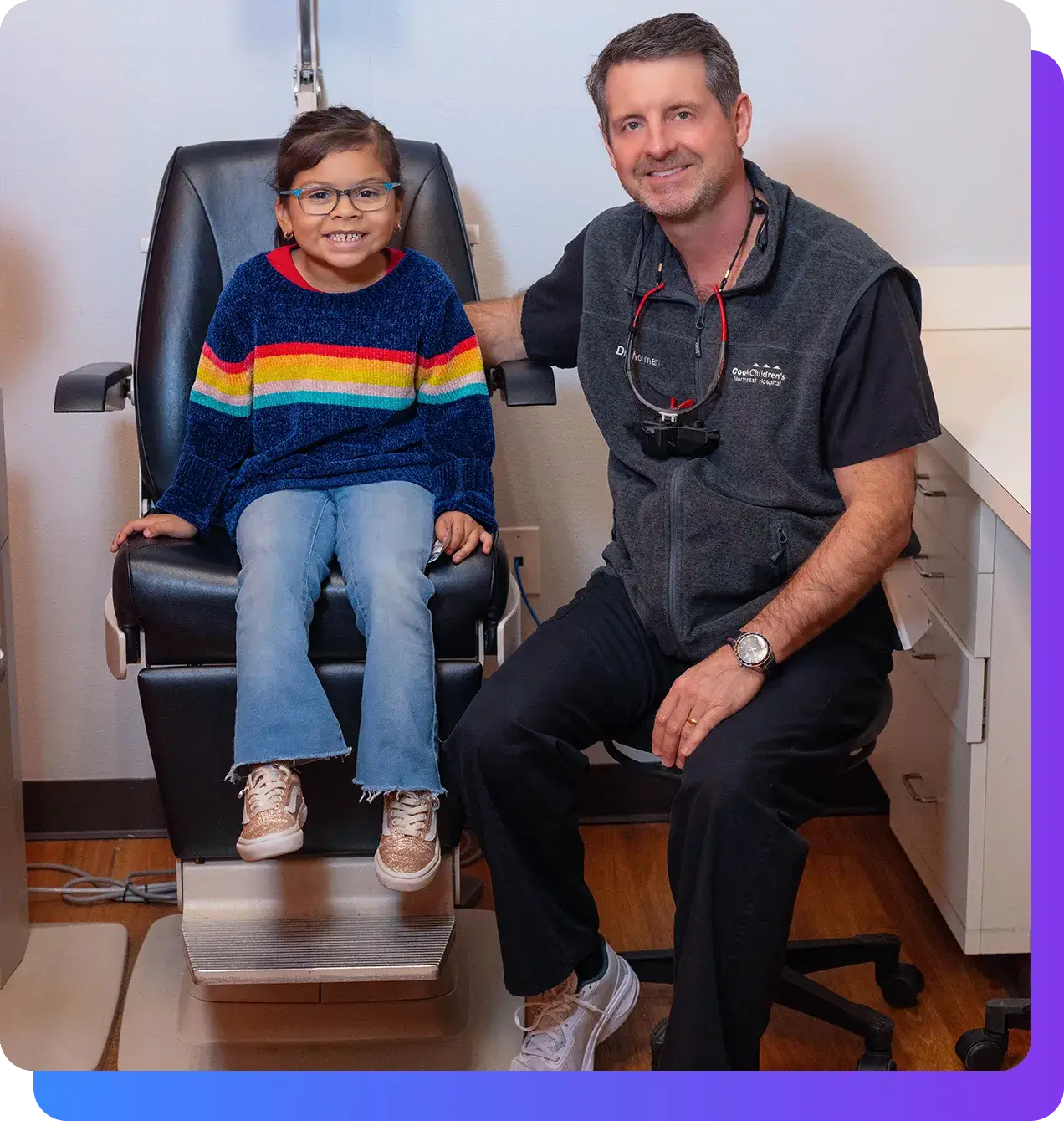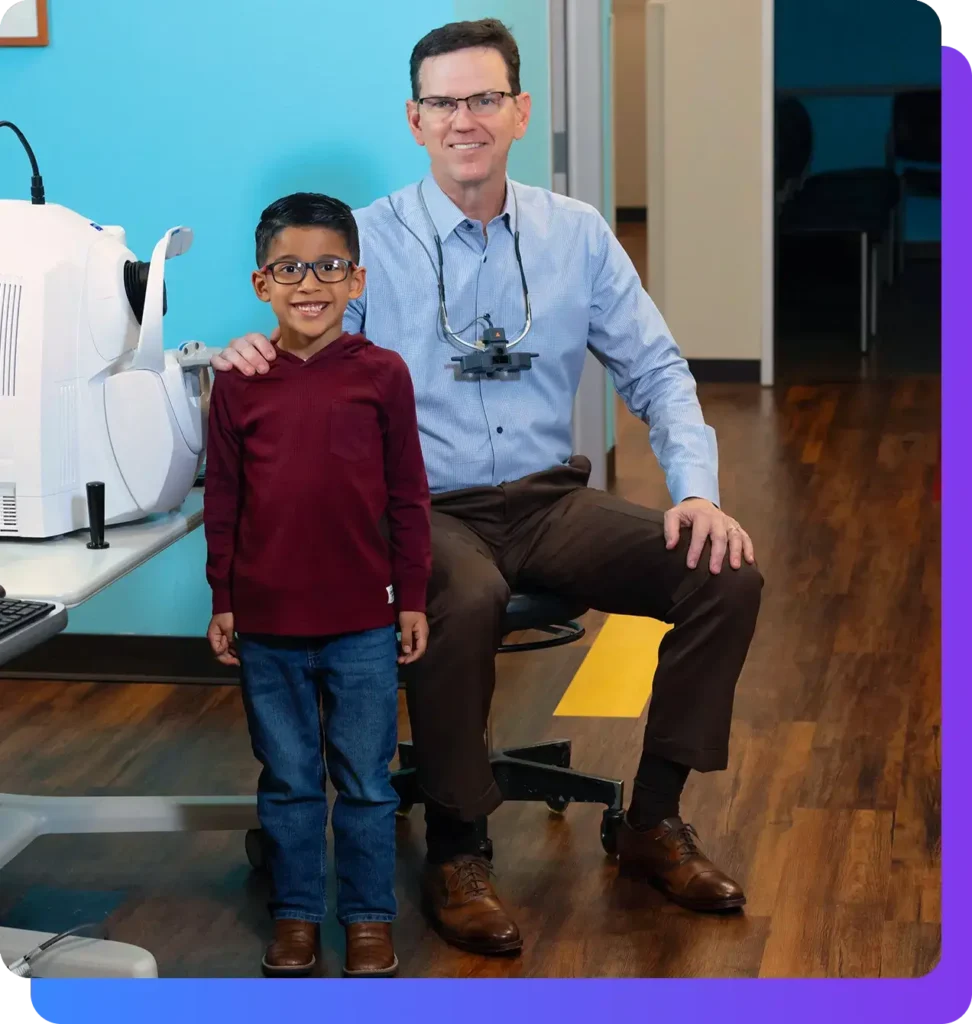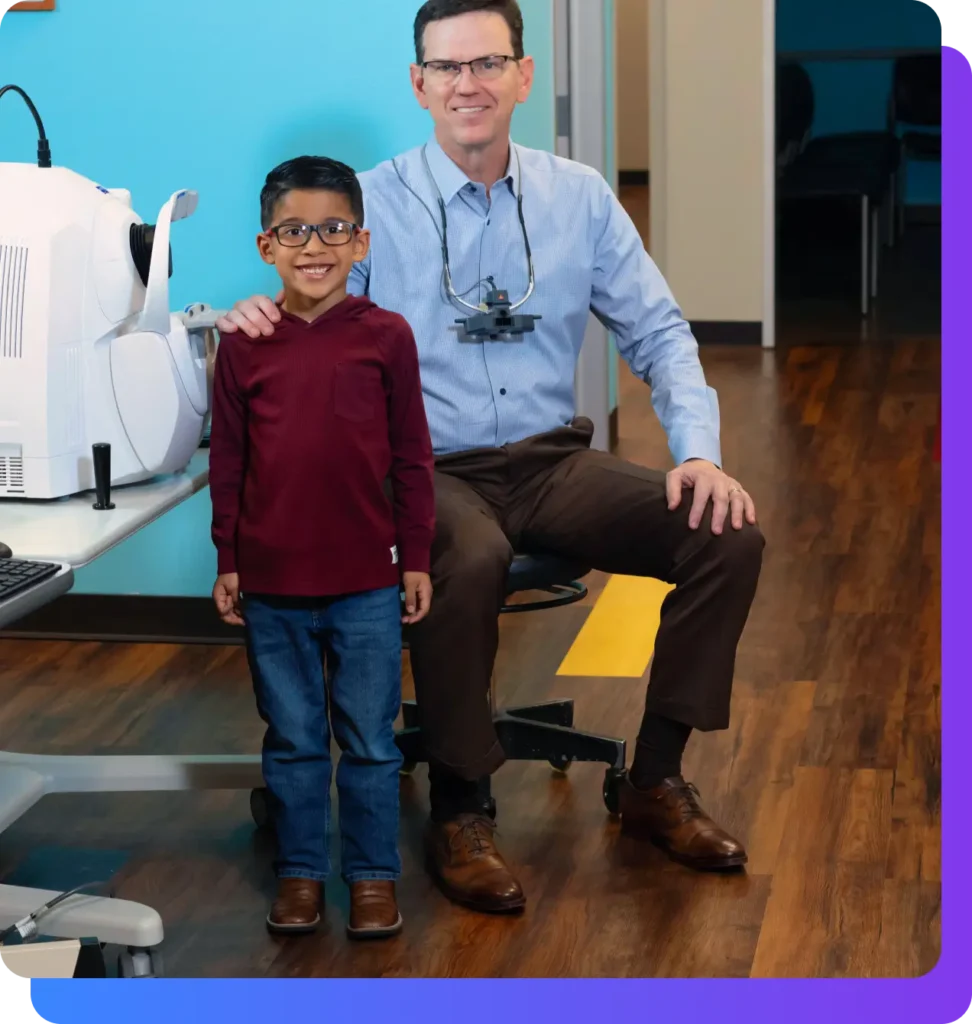Pediatric Ocular Trauma & Eye Injuries
Specialists in Fort Worth, Denton, Mansfield, prosper & Keller
Your child experiencing an ocular trauma can be an overwhelming experience. You may worry about how this injury will affect their vision, daily life, and ability to fully engage with the world around them.
Expert Pediatric Ocular Trauma Treatment for North Texas
At Pediatric Eye Specialists, we understand your concerns and are here to provide the information and reassurance you need. We are committed to supporting your child with expert care and compassionate guidance through every step of their recovery. Let us discuss ocular trauma—how it impacts your child’s vision, the potential effects on their future, and the treatment options available. We are here to offer treatment, support, and encouragement throughout this journey.

The Basics: What is Ocular Trauma in Kids?
Ocular trauma refers to eye injuries that occur in children, which can range from mild to severe and affect various parts of the eye and surrounding structures. Common causes include blunt trauma from objects like balls or fists, sharp trauma from sticks or projectiles, and chemical exposure. These injuries can impact the eyelids, the bones around the eye, and the eye itself, with two primary categories: open globe injuries (such as ruptures or lacerations) and closed globe injuries (including contusions and lamellar lacerations). Children, particularly those between ages 2 to 6, account for a significant portion of eye injuries, with boys being more frequently affected than girls. Common injuries seen in pediatric ocular trauma include corneal abrasions, hyphema, traumatic cataracts, retinal detachment, orbital fractures, and the presence of foreign bodies in the eye.
Prompt care is essential when it comes to eye injuries in children. Without quick treatment, ocular trauma can cause lasting vision problems or even blindness. Protecting your child’s vision starts with prevention, like using protective eyewear for sports or keeping sharp objects and chemical substances out of reach. If an injury does occur, getting medical help right away can make a big difference in their recovery and future eye health. Our team is here to provide the expert care your child needs to help protect and restore their vision.
Why Pediatric Eye Specialists for Pediatric Ocular Trauma Treatment
The Most Experienced Team in North Texas
With over sixty-five years of collective pediatric ophthalmology expertise, we offer your child unparalleled collaborative care.
Five Convenient Locations
Easily accessible care with offices in Fort Worth, Denton, Keller, Mansfield, and Prosper, TX.
Unrushed, Clear Communication
We take the time to discuss your child's diagnosis and treatment, ensuring all your questions are answered to ease your concerns.
Affiliated with Cook Children’s Hospital
Our partnership with Cook Children’s Hospital means if your child needs surgery, imaging, or other specialists, they will be treated in one of the nation’s leading pediatric hospitals.
Specialized Expertise
Our expertise means that more optometrists, doctors, and specialists refer their pediatric eye patients to Pediatric Eye Specialists than any other pediatric eye practice in North Texas.
Child and Family Focused
Kids love us, and we love kids! We provide a caring environment for your child and your family.
Advanced Diagnostic Technology
We have the most comprehensive pediatric diagnostic suite in North Texas, allowing for precise diagnosis and highly personalized treatment plans.
Every Child Needs Access to Expert Eye Care
Championing the right to sight, we help you navigate insurance, cash pay, and Medicaid options to make superior eye care feasible for all children regardless of their socioeconomic status.

The Benefits of Treating Ocular Trauma
After an eye injury in children, rapid treatment can greatly improve their quality of life and reduce the risk of long-term complications. Acting quickly is essential to support healthy visual development and prevent lasting vision issues.
Success You Can Expect for Your Child
Preservation of Vision
Prompt treatment of ocular trauma is crucial to protect your child’s vision. Addressing eye injuries quickly can prevent permanent vision loss and reduce the risk of serious complications like retinal detachment, glaucoma, and infections, which could otherwise lead to blindness.
Improved Functional Outcomes
Treating ocular injuries early helps preserve the structure of the eye and supports normal visual function. Proper care also addresses injuries to surrounding areas, like the eyelids and eye socket, ensuring normal eye movement and appearance are maintained.
Prevention of Complications
Quick intervention reduces the chance of secondary complications such as infection, inflammation, and scarring. Immediate management, especially for injuries involving foreign bodies in the eye, can help prevent conditions like endophthalmitis that could further harm vision.
Better Long-Term Prognosis
Early assessment and any necessary surgical repairs can lead to better long-term visual outcomes. Proper initial treatment provides a strong foundation for any future rehabilitative care, increasing the likelihood of successful recovery.
Psychological and Emotional Benefits
Protecting your child’s vision is also essential for their emotional well-being. Maintaining clear vision helps them avoid the long-term psychological impacts of vision loss, allowing them to stay engaged with friends, family, and the world around them.
Enhanced Quality of Life
Effective treatment after an eye injury helps your child stay active and independent, enabling them to participate fully in school, play, and other activities. This contributes to their overall quality of life and supports their ongoing development.
Real Stories,
Real Smiles.
“They were very good with my nonverbal toddler. It was the best doctor visit experience we have had yet. They were awesome, caring, and quick!.”

Amy Glover
Parent of Patient
“Today, Dr. Packwood saved my youngest from a life of blindness and worked a miracle for my family. I cannot express enough gratitude and thanks for their skillful surgery and expertise. 10 of 10 highly recommend.”

Atticus Lee
Parent of Patient
“The staff here is so amazing with my son. We had such a wonderful experience both at the office and for his surgery! I highly recommend Pediatric Eye Specialists!!!!“

Gianna Stutzman
Parent of Patient
“We are so grateful for the genuine care that Dr. Duff provided for our son Lorenzo, which prevented him from going blind! She is truly a gift to the community.“

JS Cocjin
Parent of Patient
“Professional, compassionate, kind and friendly. They took great care of my preemie baby from Day 1 of ROP. Very happy with how my daughter is progressing and has healthy eyes now.”

Suresh K.C.
Parent of Patient
“We’ve seen Dr. Hunt for the past 6 years since my daughter was 9 days old. We have multiple appointments each year and even eye surgery when she was 1. Our experience here has been fantastic every time and we highly recommend this group!.”

Mandy Edmondson
Parent of Patient
“Dr. Norman has always been very attentive and thorough with my daughter, who has Type 1 Diabetes. The staff are warm and always do their best to be accommodating. I highly recommend Dr. Norman.”

Tricia Moon
Parent of Patient
“Absolutely recommend! All around great experience! They made my son feel comfortable during the visit. Treatment was explained, and I walked out with no questions. I loved it. “

Cynthia Valero
Parent of Patient
“Great staff, great doctors; they know how to help ease kids’ fears and provide excellent service. Had to get my little one in same day for an eye injury, and they found a way to make it happen. Would 100% recommend.“

Kris K
Parent of Patient
Start your child’s journey to better vision today.
Embrace a future of clearer vision and confidence for your child. Contact us now to book your consultation at any of our convenient locations across the Metroplex.
Click to Explore Eye Inuries & Ocular Trauma
Causes of Eye Injuries
At Pediatric Eye Specialists, we understand that children are naturally curious and active, which sometimes leads to accidents that can injure their eyes.
Common causes of ocular injury in kids include falls and accidental bumps, especially in younger children. Sharp objects like scissors or glass can also be dangerous in a child’s hands, and mishandling them can lead to serious injuries.
Sports and playtime activities are another common source of eye trauma—balls, toys, and even playful roughhousing can result in injuries that may need medical attention. Everyday household items like wooden sticks and even things as simple as fingernails can also cause harm.
Many of these injuries happen at home, where children feel safest, and also in playgrounds and other areas they frequent. Fortunately, a lot of these incidents are preventable. We encourage parents to keep potentially harmful objects out of reach, educate children on safe play, wear eye protection when appropriate and always be mindful of eye safety.
At Pediatric Eye Specialists, we’re here to help if accidents happen, providing expert care and support for your child’s vision.
Understanding the specific cause of injury and resulting damage is vital for Pediatric Eye Specialists in diagnosing and formulating an effective treatment plan for ocular trauma.
Recognizing the Signs and Symptoms of Ocular Injuries
Identifying the signs of ocular trauma early is essential to get the right treatment for your child and prevent lasting vision issues. Eye injuries can vary widely in severity, but here are some symptoms to watch for:
Pain and Discomfort
Children who have suffered an eye injury may complain of pain, a feeling that something is in their eye, or discomfort, especially with eye movement. Younger children might not express pain verbally, but may rub their eyes, squint or close their eyes.
Visual Changes
An eye injury can lead to blurry or double vision, decreased vision, or even partial or total vision loss. Other signs include flashes of light or floaters in their vision, which may indicate more serious internal eye damage.
External Signs
Visible signs of an eye injury include redness, tearing, swelling or bruising around the eyelids (often called a “black eye”), and bleeding or unusual discharge. A bright red patch on the white part of the eye, known as subconjunctival hemorrhage, may also be present.
Pupil Abnormalities
Changes in pupil size, shape, or response to light can be indicators of trauma. Look for pupils that are unequal in size, irregularly shaped, or unusually sensitive to light.
Light Sensitivity
Sensitivity to light, or photophobia, can develop after an eye injury, causing discomfort in bright conditions.
Other Symptoms
Additional signs to be aware of include headache, tenderness around the eye, or numbness in parts of the face near the injury site.
Specific Injuries
Certain injuries, such as hyphema (blood in the front of the eye), lens dislocation, retinal detachment, or signs of a ruptured globe, are particularly serious and require immediate medical care.
The severity and combination of symptoms can vary depending on the nature of the injury. Any eye injury that results in visual changes, intense pain, or severe symptoms should be evaluated by a specialist right away to protect your child’s vision.
Still Have Questions?
Signs of childhood ocular trauma are often clear, but a thorough eye examination is essential to fully understand the injury’s impact. If you notice any symptoms, consult a pediatric ophthalmologist for a thorough eye examination. Early diagnosis and prompt treatment are essential to achieving the best possible outcomes for children with eye injuries.
Diagnosing Ocular Trauma
At Pediatric Eye Specialists, we know how concerning it is when your child has an eye injury. Diagnosing ocular trauma involves a gentle but thorough exam to understand the injury fully and decide on the best treatment. During the exam, our pediatric ophthalmologist will carefully examine each eye to see how the injury may have affected your child’s vision.
To get a clear view inside the eye, we may use imaging tools. An ultrasound helps us analyze the retina and vitreous cavity. In some cases, a CT scan is needed to check for broken bones around the eye or any objects that may have gotten into the eye. Specialized scans, called OCTs, or Optical Coherence Tomography, give us more details about the front and back of the eye, allowing us to spot anything that might affect your child’s vision and healing.
The exact tests we use depend on your child’s specific injury and needs. Our team combines these tools with a compassionate approach to ensure we’re giving your child the best care possible, focusing on their comfort and visual outcome every step of the way.
Treatments for Kids Eye Injuries & Ocular Trauma
Treating ocular trauma involves immediate management, medical treatment, and, in some cases, surgical intervention. At Pediatric Eye Specialists, our priority is to protect and stabilize your child’s eye as soon as possible. In cases of severe trauma, we’ll shield the eye to prevent further damage and avoid any touching or pressure on the injured area. For chemical injuries, quick and thorough rinsing of the eye is essential.
Medical treatment may include antibiotics to prevent infection, eye drops to reduce pain and inflammation, and medication to keep the eye comfortable and protected. For injuries like corneal abrasions, we may use antibiotic ointments and apply a protective patch, while eye drops are used to manage pain in cases of hyphema, an eye bleed.
For more serious injuries, surgical procedures might be necessary. Open globe injuries are ideally repaired within 24 hours to reduce the risk of infection. Corneal wounds or lacerations may need repair, and some cases may require surgery to remove blood or repair a detached retina. If the trauma has caused a cataract, a procedure called lensectomy may be needed to restore vision.
Our team uses a multidisciplinary approach, collaborating with specialists in different areas of eye care to ensure a well-rounded treatment plan. Follow-up care is crucial to monitor healing, check vision and eye pressure, and address any complications that may arise. With prompt and tailored care, our goal is to help your child recover as fully as possible.
Typical Expected Outcomes for Ocular Trauma
The outcomes of ocular trauma in children can vary, depending on how severe the injury is, where it’s located, and how quickly treatment begins. Some children may fully recover their vision, while others may have lasting vision challenges. Studies show that with proper care, many children experience good visual outcomes, though in some cases, trauma can lead to significant vision loss in one or both eyes.
The initial severity of the injury is a strong indicator of how well a child’s vision may recover. Closed injuries, where the eye itself is not cut or punctured, often have better outcomes than open injuries. Quick treatment is essential, as prompt care can often prevent complications that could affect long-term vision.
Certain types of injuries come with specific risks. Open injuries may require surgery and carry a higher risk of infection or retinal detachment, which can lead to additional vision problems. Even with good treatment, some children may still experience issues like scarring or reduced eye function, which can affect depth perception and how they see things around them.
For many children, recovering from an eye injury can impact more than just their vision—it can also affect their confidence and interactions with others. In younger children, injuries may even affect their visual development, making timely treatment especially important.
At Pediatric Eye Specialists, we are committed to providing expert, compassionate care to help your child achieve the best possible outcome and support their overall well-being.
Secure a Brighter Future: Schedule You Child's Ocular Trauma Consultation Today
Do not let ocular trauma obscure your child’s vibrant future. Schedule an appointment with Pediatric Eye Specialists to ensure your child receives the expert treatment and care they deserve. Take the first step towards clear vision and a lifetime of possibilities for your child—contact us now.

Start your child’s journey to better vision today.
Embrace a future of clearer vision and confidence for your child. Contact us now to book your consultation at any of our convenient locations across the Metroplex.
This section addresses common questions and concerns about eye injuries in kids. From treatment options and timelines to insurance and payment queries, we aim to provide clear, concise answers.
What are the most common eye injuries in children?
Common eye injuries in children include corneal abrasions (scratches on the eye surface), foreign objects in the eye, blunt trauma from sports or falls, and chemical exposure. Each of these injuries requires quick evaluation to avoid further complications. Pediatric Eye Specialists can help diagnose and treat all types of pediatric eye injuries to ensure your child’s eye heals well.
How can I tell if my child’s eye injury is serious?
Signs of a serious eye injury include noticeable pain, redness, swelling, vision changes (blurriness or vision loss), and sensitivity to light. If you notice these symptoms or if your child is in significant discomfort, seek prompt medical attention. Pediatric Eye Specialists can provide a thorough assessment to determine the best course of action.
What should I do immediately if my child has an eye injury?
If your child has an eye injury, avoid touching the eye and cover it gently with a shield or clean cloth to protect it, without applying pressure. For chemical exposure, rinse the eye with clean water for several minutes. It’s important to see a specialist as soon as possible. Pediatric Eye Specialists offer urgent care for eye injuries to help minimize any potential vision loss.
Can an eye injury lead to permanent vision loss in children?
Some eye injuries, if not treated quickly, can lead to lasting vision issues or even permanent vision loss. However, with timely and appropriate treatment, many children achieve good visual recovery. Pediatric Eye Specialists focus on quick intervention to give your child the best possible chance of recovering their vision.
How is ocular trauma treated in children?
Treatment for ocular trauma depends on the type and severity of the injury. This can range from protective shielding, antibiotics, and eye drops to surgical procedures in severe cases. At Pediatric Eye Specialists, we offer a full range of treatments tailored to each child’s specific needs to help them heal quickly and safely.
How long does it take for a child’s eye injury to heal?
Healing times vary depending on the injury. Minor injuries may heal within a week, while more serious injuries can take weeks to months to fully recover. Pediatric Eye Specialists will monitor your child’s recovery closely to ensure proper healing and adjust treatment as needed.
Can eye injuries in children affect their vision development?
Yes, eye injuries, especially in younger children, can impact their visual development if not properly managed. Prompt treatment is key to preventing long-term vision issues like amblyopia (lazy eye). Pediatric Eye Specialists prioritize timely care to support both recovery and normal visual development.
Should my child avoid certain activities after an eye injury?
After an eye injury, it’s best to limit activities that could strain or further injure the eye, such as sports or rough play. Your specialist at Pediatric Eye Specialists will give you guidance on which activities to avoid and when your child can safely resume them. Injuries requiring surgical repair can result in limitation of activities for six weeks or more.
What follow-up care is needed after an eye injury?
Follow-up care may involve regular check-ups to monitor healing, vision tests, and, if needed, additional treatments. Pediatric Eye Specialists will schedule follow-ups to track your child’s progress, adjust treatment if necessary, and address any concerns you may have.
How can I prevent eye injuries in my child?
Preventive steps include keeping sharp objects and chemicals out of reach, using protective eyewear during sports, and educating children about eye safety. At Pediatric Eye Specialists, we encourage parents to prioritize eye safety to protect their child’s vision.
When should my child go to the emergency department for an eye injury?
For any eye injury that involves significant pain, swelling, vision changes, or exposure to chemicals or fireworks, it’s best to go to the emergency department right away. The human eye is sensitive, and quick evaluation can make a big difference in preventing visual impairment and preserving your child’s visual perception.
Should my child wear protective eyewear to prevent eye injuries?
Yes, protective eyewear, such as goggles or glasses, is highly recommended, especially during sports and activities involving fireworks or other high-risk items. Protective eyewear can help shield the human eye from injuries that might otherwise lead to visual impairment. Pediatric Eye Specialists encourage safety habits to reduce the risk of preventable injuries that may otherwise require medical health care.
What are the most common causes of eye injuries in children?
Eye injuries in children often result from activities like sports, rough play, or exposure to sharp objects, fireworks, or chemicals. The incidence of these injuries is significant in the United States, with many children requiring treatment at an emergency department each year. Goggles and other protective glasses are recommended during high-risk activities to help reduce visual impairment from preventable injuries.